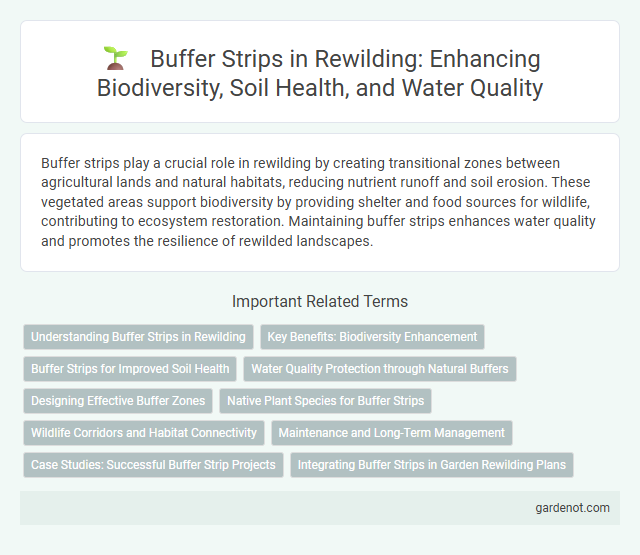Buffer strips play a crucial role in rewilding by creating transitional zones between agricultural lands and natural habitats, reducing nutrient runoff and soil erosion. These vegetated areas support biodiversity by providing shelter and food sources for wildlife, contributing to ecosystem restoration. Maintaining buffer strips enhances water quality and promotes the resilience of rewilded landscapes.
Understanding Buffer Strips in Rewilding
Buffer strips serve as essential ecological corridors in rewilding projects, providing habitat connectivity and reducing edge effects between natural and agricultural landscapes. These vegetated zones filter runoff, improve water quality, and support biodiversity by sheltering pollinators, birds, and small mammals. Effective buffer strip design incorporates native plant species and appropriate width to maximize ecosystem services and resilience in restored habitats.
Key Benefits: Biodiversity Enhancement
Buffer strips serve as vital ecological corridors that promote biodiversity enhancement by providing habitat connectivity for diverse flora and fauna. These vegetated zones reduce soil erosion and filter runoff, leading to improved water quality and healthier ecosystems. By supporting pollinators, birds, and beneficial insects, buffer strips contribute significantly to the restoration of natural habitats within agricultural landscapes.
Buffer Strips for Improved Soil Health
Buffer strips, characterized by vegetation planted along waterways or field edges, significantly enhance soil health by reducing erosion and runoff. These vegetative barriers trap sediments and nutrients, preventing them from polluting nearby water bodies while improving soil organic matter and microbial diversity. Implementing buffer strips as part of rewilding projects promotes long-term agricultural sustainability and ecosystem resilience.
Water Quality Protection through Natural Buffers
Buffer strips composed of native vegetation act as natural filters that reduce sediment, nutrient runoff, and pollutants entering water bodies, significantly enhancing water quality. These riparian buffers stabilize stream banks, prevent erosion, and provide habitat for wildlife, contributing to ecosystem resilience. Implementing buffer strips in agricultural and urban landscapes supports rewilding efforts by promoting biodiversity and safeguarding freshwater resources.
Designing Effective Buffer Zones
Effective buffer strips are essential in rewilding projects to protect natural habitats from agricultural runoff and soil erosion. Designing buffer zones involves selecting native vegetation that enhances biodiversity while stabilizing soil and improving water quality. Optimal buffer width varies by landscape but typically ranges from 10 to 30 meters to maximize ecological benefits and habitat connectivity.
Native Plant Species for Buffer Strips
Buffer strips consisting of native plant species enhance biodiversity by providing habitat connectivity and supporting pollinators in rewilding projects. These strips serve as effective natural filters, reducing soil erosion and water runoff while promoting soil health through deep root systems. Incorporating native flora such as wildflowers, grasses, and shrubs ensures ecological resilience and sustainability in restored landscapes.
Wildlife Corridors and Habitat Connectivity
Buffer strips serve as critical wildlife corridors that enhance habitat connectivity by linking fragmented ecosystems and allowing safe passage for various species. These vegetated zones reduce edge effects and support biodiversity by providing essential resources such as food, shelter, and breeding grounds. Implementing buffer strips strategically strengthens landscape-scale ecological networks, promoting gene flow and species resilience in rewilding projects.
Maintenance and Long-Term Management
Buffer strips require regular maintenance, including removal of invasive species and periodic monitoring to ensure native vegetation thrives. Long-term management involves adaptive strategies that respond to ecological changes, maintaining habitat connectivity and water quality. Effective stewardship balances vegetation growth with erosion control to sustain biodiversity benefits over time.
Case Studies: Successful Buffer Strip Projects
Buffer strips have proven effective in various rewilding projects by reducing soil erosion, improving water quality, and enhancing biodiversity. Case studies from the Chesapeake Bay watershed demonstrate that riparian buffer strips reduced nitrogen runoff by up to 40%, while projects in the Midwest U.S. restored native vegetation corridors that significantly increased habitat connectivity for wildlife. European initiatives, such as the Danish agroforestry buffer strips, showcased improved bird populations and pollinator diversity within just five years of implementation.
Integrating Buffer Strips in Garden Rewilding Plans
Integrating buffer strips in garden rewilding plans enhances biodiversity by providing habitat corridors for pollinators, birds, and beneficial insects. These vegetated zones reduce soil erosion, improve water quality, and support native plant species, creating a seamless transition between cultivated and wild areas. Careful selection of native grasses, shrubs, and wildflowers maximizes ecological benefits and resilience in garden ecosystems.
Buffer strip Infographic

 gardenot.com
gardenot.com